Qiu X.G. (Ed.) High Temperature Superconductors
Подождите немного. Документ загружается.

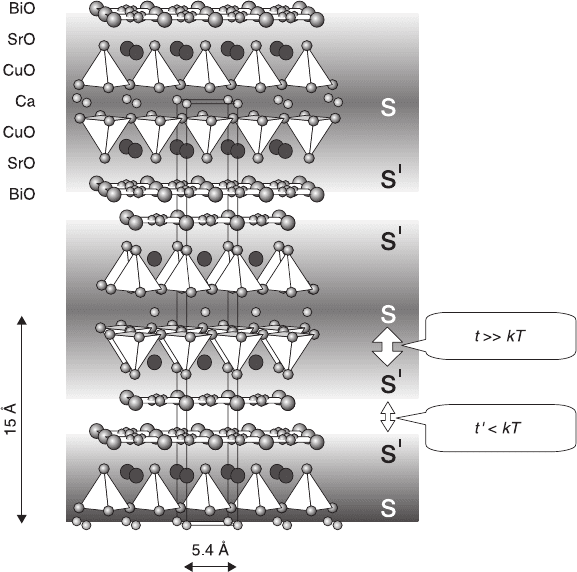
322 High-temperature superconductors
1
2
3
4
5
6
7
8
9
10
1
2
3
4
5
6
7
8
9
20
1
2
3
4
5
6
7
8
9
30
1
2
3
4
5
6
7
8
9
40
1
2
43X
© Woodhead Publishing Limited, 2011
For the high-T
c
superconductors (HTS) these models can be adapted, leading to
device parameters scaling with the higher T
c
. This results in promising properties in
comparison to conventional low-T
c
(LTS) superconductors (Beasley, 1995). For
example the frequency range is now extended to several THz. On the other hand, the
nature of the high-T
c
materials results in new aspects like anisotropy of the parameters
with crystal orientation, pairing symmetry (d-wave instead of conventional s-wave),
high penetration depth and small coherence length. An excellent review on weak links
in high critical temperature superconductors is given by Tafuri and Kirtley (2005).
Another physics is related to high-T
c
cuprate superconductors because they have an
atomically layered structure of superconducting sheets S and S′ separated by insulating
or normal conducting layers with different coupling strengths t and t′, respectively (see
Fig. 8.3). In this way the weak coupling is realized in a periodic stack of Josephson
junctions with atomic dimensions along the crystallographic c-axis. These intrinsic
Josephson junctions can be described by the Josephson or more general weak link
8.3 Intrinsic Josephson junctions within the unit cell of the high-T
c
superconductor Bi
2
Sr
2
CaCu
2
O
8
(Yurgens, 2000, Fig.1, Copyright (2000) by
IOP Publishing Ltd). Reprinted with permission from Yurgens A (2000)
‘Intrinsic Josephson junctions: recent developments’, Supercond. Sci.
Technol. 13, R85–R100, Fig.1. Copyright (2000) by IOP Publishing Ltd.
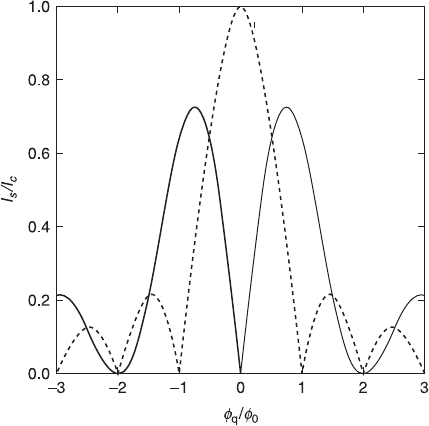
High-T
c
Josephson junctions 323
1
2
3
4
5
6
7
8
9
10
1
2
3
4
5
6
7
8
9
20
1
2
3
4
5
6
7
8
9
30
1
2
3
4
5
6
7
8
9
40
1
2
43X
© Woodhead Publishing Limited, 2011
physics but the small dimensions as well as the series connection of many junctions
gives rise to some special behaviour and parameters (so-called intrinsic Josephson
effects). Modelling of high-T
c
Josephson junctions has to take into account these
special properties. Thus within the last years many improved, adapted or new models
have been introduced to describe the physics of high-T
c
Josephson junctions. I
c
(T) or
I
c
R
N
(T) have been calculated for d-wave superconductors and different kinds of
coupling barriers, see e.g. Tanaka and Kashiwaya (1997), Golubov and Tafuri (2000),
Yokoyama et al. (2007), and references therein. As one example of the unusual
behaviour, it should be pointed out that the magnetic field pattern in the case of a hybrid
junction with one electrode with d-wave symmetry (S
s
IS
d
junction) drastically changes,
resulting in a zero critical current without field (so called ‘
π
-junction’), see Fig. 8.4.
8.1.3 Possibilities of applications
There are many applications of Josephson junctions or related weak link devices
in superconducting electronics and measurement science. The superconducting
quantum interference device (SQUID), as the most prominent application, will
be treated in the next chapter. Thus single junction and junction array applications
8.4 Magnetic field pattern of a conventional Josephson junction,
eq. [8.2] (dashed line), and a hybrid
π
-junction of a d-wave high-T
c
superconductor and an s-wave low-T
c
superconductor (Tafuri and
Kirtley, 2005, Fig. 19b. Copyright (2005) by IOP Publishing Ltd).
Reprinted with permission from Tafuri F and Kitley JR (2005), ‘Weak
links in high critical temperature superconductors’, Rep. Prog. Phys. 68,
2573–2663, Fig. 19b. Copyright (2005) by IOP Publishing Ltd.
324 High-temperature superconductors
1
2
3
4
5
6
7
8
9
10
1
2
3
4
5
6
7
8
9
20
1
2
3
4
5
6
7
8
9
30
1
2
3
4
5
6
7
8
9
40
1
2
43X
© Woodhead Publishing Limited, 2011
in other fields will be discussed here.
The unique properties of Josephson devices offer interesting new systems. The
IV-characteristics (Fig. 8.2) are highly non-linear thus amplification and mixing is
possible. In the case of hysteretic junctions, there are two branches of the
characteristic which allow switching between the two states. This can be used for
latching logic and digital circuits. The modulation of the IV-characteristics in an
external magnetic field (Fig. 8.4) can be used as magnetic sensor devices similar to
SQUIDs. Photons produce characteristic changes of the IV-characteristics, too – a
broadband video detection results from changes in the characteristics connected to
the adsorbed energy of the radiation. Photon-assisted tunnelling leads to additional
structures in the IV-characteristics and Josephson junctions can be used for photon
detection down to the single-photon limit. If the frequency of the radiation is in the
range of the internal Josephson oscillations (depending on the voltage from MHz
over GHz up to the THz range) there are synchronization effects like Shapiro steps
which can be used for detection, too. Because of the fundamental relation of Eq.
[8.4], a voltage standard can be realized using the direct relation between external
frequency and voltage across the junction. The use of large junction arrays allows
exact voltages, up to 10 V as well as digital standards and a.c. voltage standards,
see Hamilton (2000). Because the Josephson oscillations are strongly connected to
the applied voltage, a tuneable frequency source can be realized. Especially in the
THz range, this offers new ways of compact radiation sources in contrast to
extended laser systems. To enhance the power of radiation instead of single
junctions, synchronized arrays of many junctions have to be used.
The dynamics of Josephson junctions can be used for many digital electronics
applications. Rapid single flux quantum (RSFQ) logic is based on the equivalence
of a voltage pulse and a single flux quantum. In contrast to the latched logic, the
switching times are very small and the dissipated power is very low. Thus SFQ or
RSFQ circuits will bring out many applications in superconducting electronics,
see ter Brake et al. (2006).
For each application, the main important parameters of the junctions have to be
realized in adapted technologies within small margins. For large junction arrays this
requires a small spread of single junction parameters like I
c
and R
N
. Stability of the
parameters on temperature during operation and on long time scales (ageing) have to
be realized. In the case of the high-T
c
Josephson junction, this situation is even more
complex and has to include a lot of additional requirements. For example, the high-T
c
materials often use adapted single crystalline substrates with high dielectric constants
resulting in decreased r.f. properties and parasitic capacitances. The small coherence
lengths result in problems of weak link dimensions and possible junction types,
including multilayer systems. On the other hand, the intrinsic nature of the high-T
c
materials offers new ways like the intrinsic Josephson junctions and phase-sensitive
junctions with new properties. For example, with the
π
-junctions a new digital logic
family can be installed, e.g. Ortlepp et al. (2007) and references therein.
High-T
c
Josephson junctions 325
1
2
3
4
5
6
7
8
9
10
1
2
3
4
5
6
7
8
9
20
1
2
3
4
5
6
7
8
9
30
1
2
3
4
5
6
7
8
9
40
1
2
43X
© Woodhead Publishing Limited, 2011
8.2 Types of high-T
c
Josephson junctions
8.2.1 Overview
The general verification of the Josephson effects for high-T
c
superconductors was
first realized by point contracts and break junctions. It was shown that even if
there are some differences to conventional superconductors, Josephson effects
can be observed which can be qualitatively described by the usual models,
especially with the same flux quantum. Meanwhile there are many types of thin
film Josephson junctions using different coupling mechanisms:
• grain boundary junctions,
• artificial barrier junctions,
• modified microbridges,
• intrinsic Josephson junctions,
• hybrid junctions.
8.2.2 Grain boundary junctions
The first group of junctions uses the special property of the high-T
c
cuprates that,
because of the very small coherence length of a grain boundary in the thin film,
acts as a weak link or Josephson junction. This strong spatially reduction of
superconductivity can be artificially induced in an epitaxial thin film. Thus a
junction can be placed in a superconducting line by induction of a grain boundary.
This can be done by modification of the substrate or an additional thin film layer
of a non-superconducting material. Most popular but quite expensive is the use of
bicrystal substrates where a single crystal substrate is cut and after some polishing
coupled again with a fixed disorder of the crystal orientation of both parts. There
are different possibilities of disorientation depending on the tilt direction and
grain boundary angle. The standard bicrystal substrate uses a well installed angle
between the a- or b-axis, while c-axis of both parts is parallel. The resulting
junction is determined by this grain boundary angle. An asymmetric or a symmetric
case can be realized (Fig. 8.5). It was shown that the dependence of the critical
current density on that angle covers a wide range (Fig. 8.6), and can be reproduced
with good accurancy, see Gross et al. (1990), Hilgenkamp and Mannhart (2002),
Gross (2005), and Mannhart (2006). This leads to commercial standards of
symmetric and asymmetric bicrystal substrates with, e.g., 24 and 36 degrees for a
lot of materials like SrTiO
3
, LaAlO
3
, NdGaO
3
, sapphire (Al
2
O
3
), MgO, Si, etc.
Other kinds of bicrystal junctions can be realized if there is a tilt with respect to
the ab-planes or c-axis of both parts of the crystal. Because of the anisotropy and
the d-wave symmetry in the high-T
c
materials, such substrates can be used to
realize junctions with different superconducting phase coupling.
Another way of inducing a well-defined grain boundary in the growing high-T
c
film is a step-edge in the substrate. It was shown that for angles larger than

326 High-temperature superconductors
1
2
3
4
5
6
7
8
9
10
1
2
3
4
5
6
7
8
9
20
1
2
3
4
5
6
7
8
9
30
1
2
3
4
5
6
7
8
9
40
1
2
43X
© Woodhead Publishing Limited, 2011
8.5 Two types of bicrystal junctions with (a) asymmetric and (b)
symmetric grain boundaries (Tafuri and Kirtley, 2005, Fig. 23, Copyright
(2005) by IOP Publishing Ltd.). Reprinted with permission from
Tafuri F and Kitley JR (2005), ‘Weak links in high critical temperature
superconductors’, Rep. Prog. Phys. 68, 2573–2663, Fig. 23. Copyright
(2005) by IOP Publishing Ltd.
60 degrees there are well-pronounced grain boundaries at both ends of the
substrate step induced in the high-T
c
film during deposition (Fig. 8.7). Depending
on step angle and substrate material as well as technology, one or two junctions
will be established. There was some discussion and investigation of the crystal
structure concerning the question of whether the lower or upper step-edge
determines the junction with the lower critical current dominating the
IV-characteristics of the whole contact. In general the existence of two junctions
in series causes problems in the dynamics and the stability of the system, see
Seidel et al. (1995). Thus one tries to make both junctions very different in their
critical current. Another way is to avoid a second junction, as is done for MgO
step-edges by Foley et al. (1999) where only the upper junction exists, while at
the lower end of the step-edge there is a smooth growth of the film.
A general advantage of the step-edge junctions in comparison to bicrystal
junctions is that they can be placed anywhere on a flat, quite cheap substrate. By
etching the step into a thin film of an insulating material with crystallographic
parameters allowing growth of the high-T
c
material in the top layer, the junctions
can be placed in higher levels of multi-layered devices, too.
The third possibility, to produce an artificial grain boundary in the high-T
c
film,
is the so-called biepitaxial junction (Fig. 8.8). A seed layer partially covers the
substrate and the material of the seed layer induces another orientation of the film
growth in comparison to the uncovered regions of the substrate. The disadvantage
of this type of junction is that often there is only a fixed angle between the two
film parts of 45 degrees, which is not optimal with respect to critical current (see
Fig. 8.6). A placement of the junction anywhere on the substrate is an advantage,
including multi-layer technology. Thus a junction can be realized very easily in
the upper layers of a thin film system.
The grain boundary junctions offer an excellent standard technology for many
applications. Even if the nature of the barrier and the coupling mechanism is still
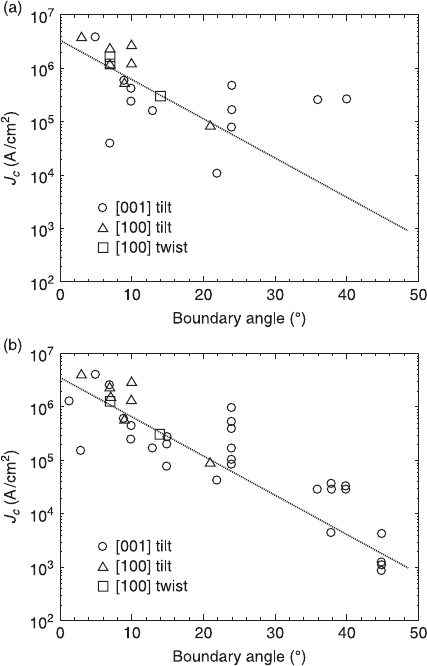
High-T
c
Josephson junctions 327
1
2
3
4
5
6
7
8
9
10
1
2
3
4
5
6
7
8
9
20
1
2
3
4
5
6
7
8
9
30
1
2
3
4
5
6
7
8
9
40
1
2
43X
© Woodhead Publishing Limited, 2011
under discussion, see for example Hilgenkamp and Mannhart (2002) and
references therein, they give a high reproducibility and good performance like a
high I
c
R
N
product.
8.2.3 Artificial barrier junctions
This kind of Josephson junction uses an artificial barrier layer between the
superconductors and various geometries (Fig. 8.9). Depending on the nature of the
barrier material (insulating, semiconducting, normal conducting, superconducting
8.6 Critical Josephson current density on grain boundary angle at 4.2 K
of different bicrystal junctions, reproduced from Mannhart, 2006, Fig. 4
a and b; for details see comments therein. Reprinted with permission
from Mannhart J (2006), ‘Properties of grain boundaries in high-T
c
superconductors – Notes on a recent presentation’, Physica C 450,
152–155, Fig. 4 a and b, Copyright (2006) by Elsevier Science Ltd.
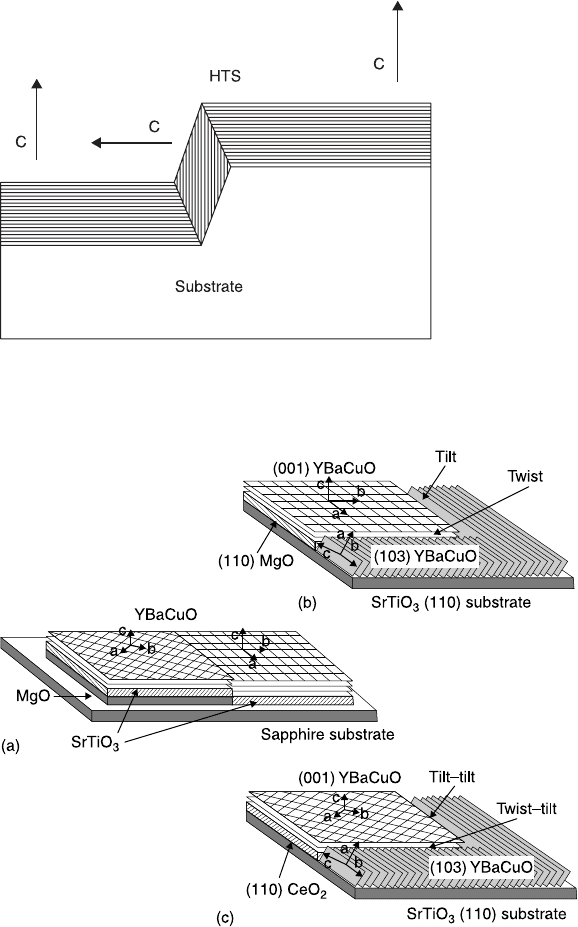
328 High-temperature superconductors
1
2
3
4
5
6
7
8
9
10
1
2
3
4
5
6
7
8
9
20
1
2
3
4
5
6
7
8
9
30
1
2
3
4
5
6
7
8
9
40
1
2
43X
© Woodhead Publishing Limited, 2011
8.7 Step-edge junction with two grain boundaries induced in the HTS
film (shown schematically). C = c-axis direction of the crystals.
8.8 Biepitaxial junction types (shown schematically): (a) classically,
(b) MgO-based and (c) CeO-based out-of-plane type (Tafuri and Kirtley,
2005, Fig. 24, Copyright (2005) by IOP Publishing Ltd). Reprinted with
permission from Tafuri F and Kitley JR (2005), ‘Weak links in high
critical temperature superconductors’, Rep. Prog. Phys. 68, 2573–2663,
Fig. 24. Copyright 2005 by IOP Publishing Ltd.
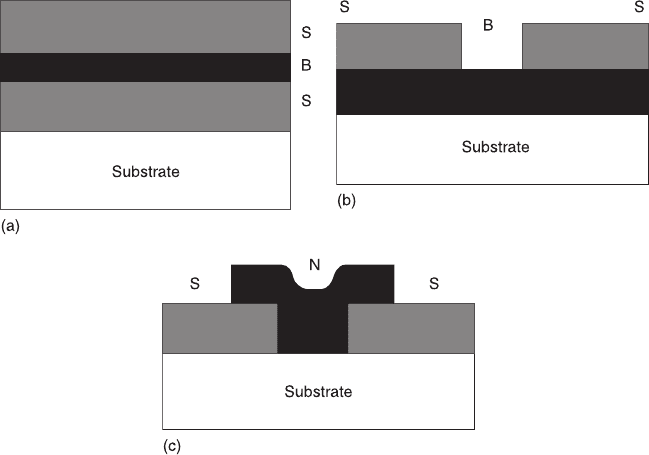
High-T
c
Josephson junctions 329
1
2
3
4
5
6
7
8
9
10
1
2
3
4
5
6
7
8
9
20
1
2
3
4
5
6
7
8
9
30
1
2
3
4
5
6
7
8
9
40
1
2
43X
© Woodhead Publishing Limited, 2011
with depressed T
c
, geometrical constriction, etc.) the thickness and the transport
mechanism can vary in a wide range. Insulating barriers have to be in the order of
0.1 nm because of the very low quantum mechanical tunnelling probability. While
this SIS type in planar geometry (sandwich, Fig. 8.9a), with insulating metal
oxides is the standard junction in LTS circuits (e.g. Nb-NbO
x
-Pb or Nb-Al-
AlO
x
-Nb), the requirements of HTS technology lead to additional problems. The
insulating barrier has to grow epitaxially in layered SIS junctions in sandwich or
ramp-edge geometry, and even for a very thin barrier shorts have to be avoided.
The tunnelling probability can be drastically enhanced using semiconducting or
normal conducting barriers. But in this case the direct conductivity, Andreev
reflexion or hopping mechanisms dominate the transport through the barrier and
determine the Josephson coupling. For epitaxial growth in multilayer systems,
perovskite-like materials such as doped YBaCuO, PrBaCuO and NdCeCuO are
used. Even for such materials the problems with homogeneity, multi-layer epitaxy,
barrier thickness control and reproducibility are hard to solve, so the interfaces
play an important role.
An interesting way to reduce the problems leads to trench bilayer junctions
where the coupling barrier is deposited first, (Fig. 8.9b). The epitaxially grown
superconductor film on top of this barrier layer has to be cut by electron lithography.
8.9 Some types of planar artificial barrier junctions (shown
schematically): (a) sandwich, (b) trench in bilayer, (c) SNS trench-
bridge type. B = barrier, S = superconductor, N = normal conductor.
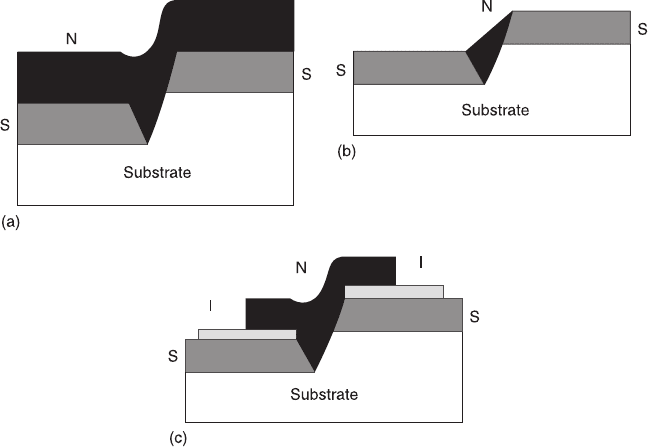
330 High-temperature superconductors
1
2
3
4
5
6
7
8
9
10
1
2
3
4
5
6
7
8
9
20
1
2
3
4
5
6
7
8
9
30
1
2
3
4
5
6
7
8
9
40
1
2
43X
© Woodhead Publishing Limited, 2011
The resulting trench has to be in the order of 100 nm to realize a proximity effect-
based coupling via the base layer. To avoid the problems with multilayer epitaxy,
a trench in a single HTS layer can be filled with normal metal (Au or Ag) resulting
in an SNS bridge junction (Fig. 8.9c). But the trench width below 200 nm, as well
as the interface problems between the HTS and the normal metal, lead to problems,
too. The first problem can be avoided with a step in the substrate, the buffer layer
or the insulating interface layer. One version is shown in Fig. 8.10a, the so-called
SNS step-edge junction (Dilorio et al., 1993, 1995).
The deposition of the normal metal and the HTS layer is realized with different
angles of incidence. These junctions show reduced I
c
R
N
-products because of the
normal shunt between large parts of the superconducting film and the normal
metal. The I
c
R
N
-product can be enhanced up to 10 mV by etching away these
shunts (Rosenthal et al., 1993), see Fig. 8.10b. Another version uses additional
insulating layers on top of the superconductor before etching the trench that leads
to capacitive shunts, (Fig. 8.10c). A widely used type with a good reproducibility
is the so-called ramp-type or ramp-edge junction, see Fig. 8.11. Here the barrier is
placed at the etched ramp of a superconductor/insulator double layer. As barrier
materials, normal metals, semiconductors or insulators can be used if they grow
epitaxially or do not strongly disturb the growth of the superconducting counter-
electrode. An interesting version uses no artificially deposited material as barrier,
8.10 Different SNS step-edge junctions (shown schematically):
(a) shunted, (b) without shunt (after etching), (c) capacitively shunted.
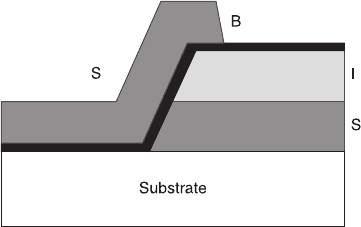
High-T
c
Josephson junctions 331
1
2
3
4
5
6
7
8
9
10
1
2
3
4
5
6
7
8
9
20
1
2
3
4
5
6
7
8
9
30
1
2
3
4
5
6
7
8
9
40
1
2
43X
© Woodhead Publishing Limited, 2011
but uses the disturbed interface at the etched ramp. This ‘natural’ barrier depends
on the etching process but is easy to realize and offers a high reproducibility
(‘interface-engineered barriers’).
Problems in barrier junction technology result from shorts and inhomogeneities as
well as from the strong influence of the intrinsic transport mechanism of the barrier
materials on the noise properties of these junctions, e.g. Sarnelli and Testa (2002).
8.2.4 Modified microbridges
This kind of junction uses artificially induced weak links in superconducting
microbridges. The modification of the superconducting material can be done by
electron, ion or proton beams if the diameter of the beam is clearly below 100 nm
(Fig. 8.12). Directly written focussed e-beam (FEBI) junctions show an excellent
Josephson behaviour but often have a low stability over time because the
modification is self-annealing at room temperature. By additional annealing
processes these problems can be solved (Pauza et al., 1997). The modification
with ions as a focussed beam as well as through masks with slit width below
150 nm are very stable over time. But besides complex dependencies on
preparation parameters, there are often problems with a very restricted range of
working temperature or with flux-flow coupling instead of Josephson behaviour.
Modified microbridges can also be obtained if in the bridge region a scratch or a
small etch trench is induced in the substrate before superconducting film is
deposited. Another type uses diffusion of material into the bridge region in a small
part of the bridge. If it is technologically possible to prepare the active part of the
bridge with geometrical dimensions in the order of the coherence length of the
superconductor, the traditional concept of nanobridges works (Fig. 8.13a). For
high-T
c
materials, the very small coherence length results in additional
requirements on the technology. If the nanobridges do not show typical flux-flow
behaviour it can be assumed that besides the geometrical dimensions (Fig. 8.13b
8.11 Ramp-type junction (shown schematically). There exist different
variations where the barrier layer is restricted to parts like the edge
only.
